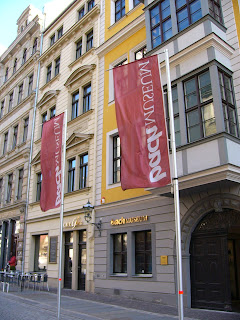Up until Thursday, the weather in Germany had been perfect –
sunny, upper 60’s, light winds. Our
final day in Berlin was more along the lines of the weather I had expected to
encounter – cool, damp and rainy. We
didn’t let that stop us from seeing some more of Berlin’s highlights.
We started with a closer look at some of the things our
guide had highlighted on the walking tour, specifically the Topography of
Terror and the Stasi Museum. As I had
mentioned before, the Topography of Terror was built on the site of the former
Gestapo and SS headquarters and is bordered by one of the few remaining
sections of the Berlin Wall.
Berlin has done an excellent job of addressing the less
stellar periods in its history with memorials that both educate the visitors
and honor the victims of atrocity without being overly sensational. They hold the perpetrators accountable for
their actions and try not to present them in a way that would give those still
prejudice members of our society an opportunity to celebrate them.
The Topography of Terror was no exception. It tied together many of the things that I
learned at both Sachsenhausen and our other guided tours and gave a very
complete picture of the rise and fall of the Nazis and the atrocities committed
at the concentration camps throughout Europe.
I think it is particularly important for people of my generation,
especially those of us living in the US, to take time to remember things like
the holocaust and the communist regime.
We have so many freedoms and privileges and it is easy to take them for
granted.
Just around the corner from the Topography of Terrors, in
the middle of what was once no man’s land is the Stassi Museum. This museum honors those individuals killed
trying to escape East Germany. I don’t remember the exact numbers but there
were less than 200 individuals killed by the Stassi versus the tens of
thousands killed by the Nazis. The
museum was largely in German but one of the features I found particularly
interesting was the brief biographies and personal effects that they had of
some of the victims.
We took one final walk around Checkpoint Charlie before
hopping on the U-bahn to the New Synagogue.
While the synagogue was not burned in the Kristallnacht, its dome was
destroyed by bombings in World War II. The dome wasn’t rebuilt until the
1990’s, just showing that under communist rule, no religions were
important.
The museum at the Synagogue
celebrates Jewish life in Berlin throughout the centuries and we were able to
climb to the top of the dome. This was
the first place we visited where we encountered any type of security. I’ve
truly been amazed by the lack of police presence around the city’s monuments.
Just walking through Old City in Philadelphia, there are numerous park rangers.
Before leaving the area, we stopped at the Tacheles building
that was severely damaged in World War II and subsequently condemned. Before it
could be demolished, it was taken over by a collective of artists called the
Kunsthaus Tacheles who now have squatters ‘rights. Evidently, there is a push to evict the
artists and develop the site into an upscale hotel.
We had heard of a chocolate shop in Gendarmenmarkt, the
historic square bound by the French and German cathedrals that we had visited
on our walking tour and we decided that we needed to stop in before leaving
Berlin. Fassbender & Rausch is a
family owned business that has been making its own chocolate for 150
years. They have several large chocolate
models of Berlin landmarks as well as an Erupting Chocolate Volcano.
One of the reasons Robin and I had decided to spend Thursday
in this area was that we wanted to attend the evening English church service at
the Berliner Dom. We had some extra time
so we decided to explore some of area around Gendarmenmarkt and we stumbled
upon the Mendelssohn House. I was
familiar with Felix Mendelssohn, the composer, but I was unaware that he came
from a long line of bankers, philosophers and musicians residing in this area
of Berlin.
Somehow, we went from having this abundance of extra time to
fill, to needing to rush to get dinner so we would not be late for
services. We made it back to the
cathedral just as the bells were ringing six o’clock.
The
inside of the cathedral was exquisite -- exactly what I would expect to see in
the capitol city’s main cathedral. The
interior, which was designed in the Italian Renaissance style, was filled with
paintings and lavish gold leaf relief sculptures. The service was simple with readings and
prayers conducted in both English and German.
One of the main reasons for attending the service was to hear the Sauer
organ, one of the largest in Germany with over 7,200 pipes.
We managed to make use of every minute of our time in Berlin
securing entry into the Reichstag well after 9 pm. We actually had to apply for entry a few days
before through the government website.
The German government, the Bundestag, has met at the Reichstag since
1999. The historic building was completely renovate and now includes a glass
dome, which looks down into the Great Hall where parliament meets. Inside of
the dome is a spiral walk way and we were given audio guides to point out some
of the highlights of Berlin that could be viewed below. I think that I was most fascinated by the
construction of the dome itself and the way that the metal and glass interacted
visually with one another.





















































